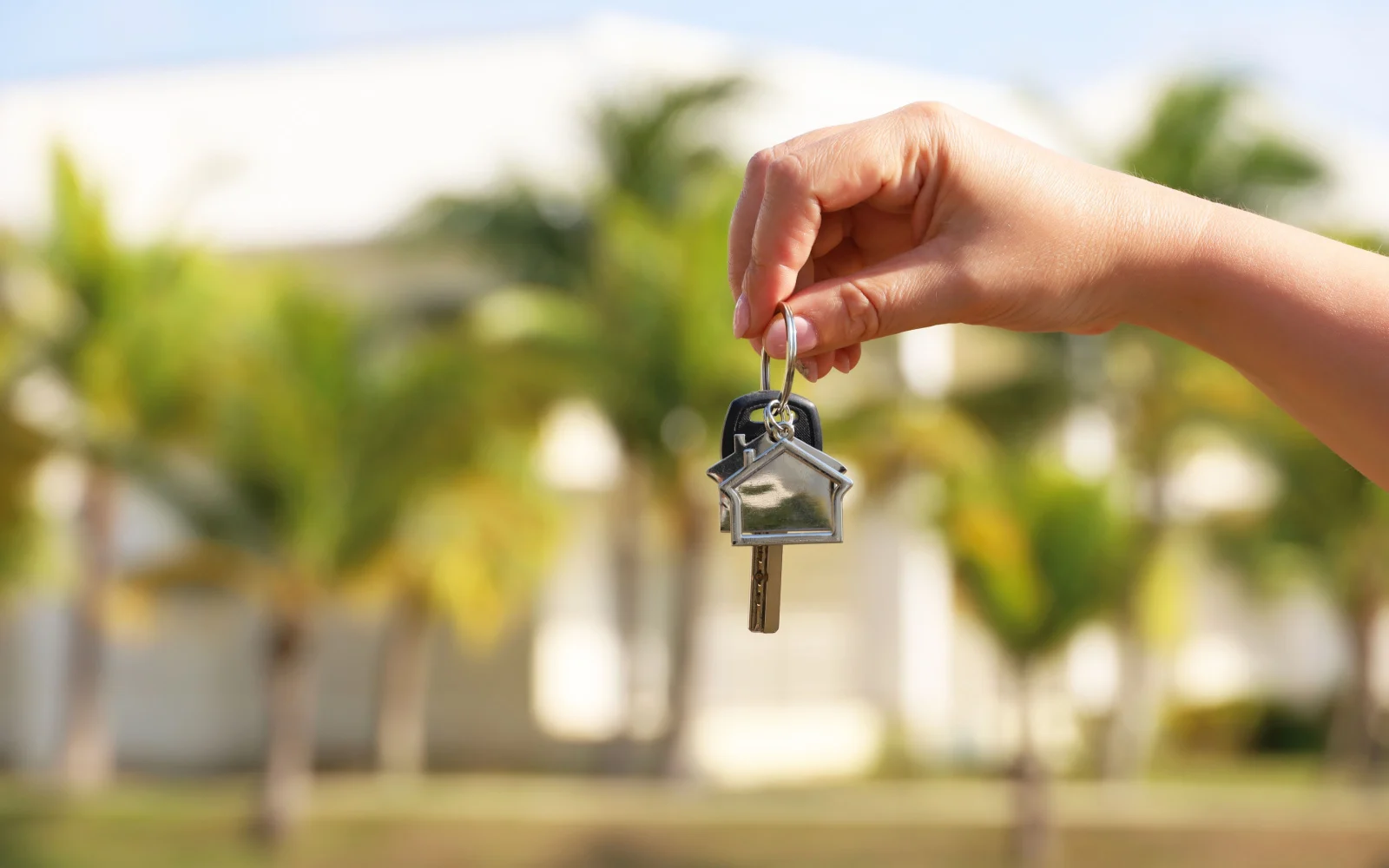Ready to pack your bags, but not sure how to move to Hawaii? Walk through the general steps to learn how to flawlessly execute your move and land in the paradise you’ve been dreaming of.
Hawaii is the #2 happiest state in the country with friendly, warm locals who value the good things in life and prioritize emotional and physical well-being.
While Hawaii has a high cost of living (housing, food, taxes, etc.), getting a good job in the islands or working remotely can make it a more affordable place to live.
If you want a slice of the tropical, happy, scenic, and vibrant pie that is Hawaii, take a look below to learn how to move to Hawaii with a few simplified steps.
How to Move to Hawaii: A 7-Step Checklist

Ivanko80/Shutterstock
Making big moves and planning on heading to Hawaii can mean mixed emotions: Excitement, uncertainty, and curiosity.
Simplify the process by reading through the general steps you’ll need to take if you’re serious about moving to Hawaii below.
- Find Your Island
- Consider the Cost of Living
- Do Some Neighborhood Research
- Look at Housing Options
- Browse Job Openings
- Sort Your Stuff to Ship or Sell
- Make the Move
After doing a quick overview of the 4 main Hawaiian islands and what they offer, consider the cost of living of each one to settle on the right one for you.
Next, you’ll dive into some neighborhood research to determine the best areas to move to on the island of your choice.
After looking at housing options in the area, you can start looking at potential job options by seeing what’s available.
The meat and potatoes portion of the process comes when you start sorting through your possessions to see what’s ship-worthy and what should be sold to finance your move.
Finally, you’ll be tying up loose ends and making the process official by renting or purchasing a home and going forward with your move.
1. Find Your Island
You’ll likely be deciding between Hawaii’s 4 main islands: Oahu, Hawai’i (The Big Island), Maui, and Kauai.
Knowing how many people live in the Hawaii islands is a good place to start to see how crowded or secluded each island is.
Knowing the general culture, infrastructure, and landscape of each island is also helpful to narrow down your options. Let’s take a look.
Oahu
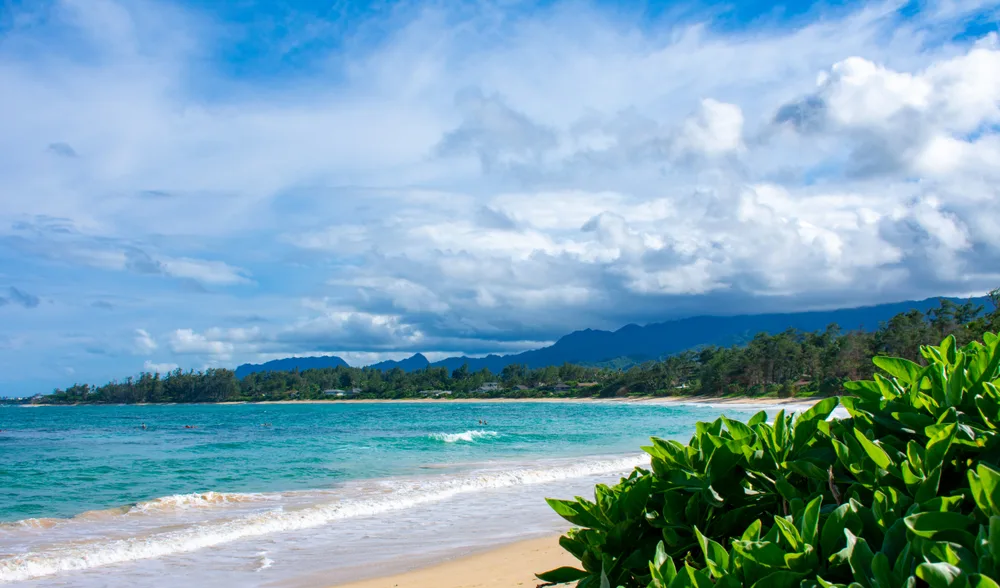
Mikela Bond/Shutterstock
Oahu, known as The Gathering Place, is a gorgeous and historic island famous for its vast, tropical beaches, rugged North Shore, the Diamond Head volcanic crater, and lush rainforests.
Oahu’s population is the biggest of all the Hawaiian islands at a little over 1 million people and 1,704 people per square mile.
If you enjoy exploring the city as much as you do spending time on the beach, vibrant nightlife, and a wide range of things to do, you’ll love Oahu.
The island is home to the capital, Honolulu and famous areas like Pearl Harbor, the North Shore, and Waikiki Beach.
Oahu is the island most people consider moving to because it’s highly developed with plenty of jobs, housing, restaurants, grocery stores, shops, and services.
You’ll find the most amenities and a lifestyle that’s similar to the mainland, but still distinctively Hawaiian, on Oahu.
For most people, this will be the best and most well-rounded island for a move from the mainland. You’ll find the most jobs and housing options on Oahu, but the cost of living is higher.
Hawai’i
The Big Island, Hawai’i, has the 2nd-largest population but is much less densely populated with around 200,600 people on the island and just 50 people per square mile.
Hawai’i accounts for around 62% of Hawaii’s total landmass, truly earning its nickname of the Big Island.
If you want unspoiled rocky, golden, or black-sand beaches, gorgeous national parks, awe-inspiring volcanoes, lush rainforests, and a vibrant community feel, Hawai’i might be for you.
It’s less developed than Oahu with vast rural zones, but you’ll find more jobs, housing, restaurants, grocery stores, and services near the population centers of Kailua-Kona and Hilo.
The cost of living on the Big Island is also about half that of Oahu, though still more expensive than the national average.
Maui
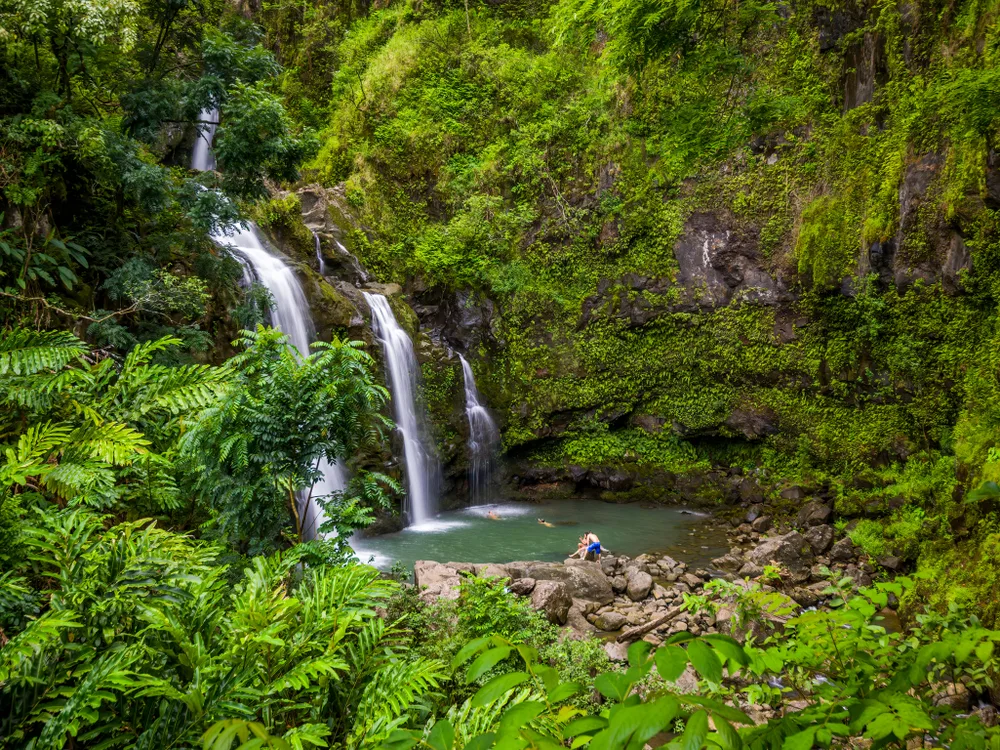
arkanto/Shutterstock
Maui is known as the Valley Isle and popular for its beautiful beaches, green-blanketed mountainous topography, cascading waterfalls, and long, scenic roads that wind through the island.
With the 3rd-largest population in Hawaii, Maui is home to around 164,200+ people with about 226 people per square mile. It’s not nearly as populated as Oahu, but more crowded than the Big Island.
Maui is very developed with plenty of jobs, restaurants, attractions, grocery stores, and services offered throughout the island.
There are some remote and secluded areas, like Hana, where few people live that feel much more isolated.
After the Lahaina wildfires, Maui’s housing has struggled to accommodate the displaced citizens after over 3,000 homes and apartments were destroyed.
This housing shortage is something important to consider if you’re thinking about moving to Maui.
Kauai
Kauai, known as the Garden Isle, is one of the most naturally beautiful and unspoiled-yet-developed islands in Hawaii.
Green valleys and mountains, rainforests, botanical gardens, and waterfalls make Kauai truly gorgeous. It’s famous for its ridged and rugged Na Pali coast.
People seeking a less-crowded, scenic, and secluded island will love Kauai. It’s developed enough to offer convenience, but wild enough to create a bit of a shock if you’re moving from the mainland.
Kauai’s population is the 4th-largest in Hawaii, but worlds away from the crowds of Oahu, Hawai’i, and Maui with under 73,300 people (about 133 people per square mile).
Kauai offers less in the way of jobs than some of the other islands, but skilled trades, hospitality, and transportation jobs are all great options on the island.
Housing can be a struggle on Kauai, where almost 15% of homes are short-term rentals and a widespread housing shortage create higher rents and home prices.
2. Consider the Cost of Living
Once you’ve pared down your list of potential islands to move to in Hawaii, you’ll need to consider how much it’ll cost to live there.
The cost of living in Hawaii is the highest in the nation — almost double the national average. To live comfortably in Hawaii, you’ll need to make around $195,300/year.
When you’re considering how to move to Hawaii, don’t forget to factor in that higher cost of living and what you’ll need to make it work.
Hawaii’s housing costs are worth considering if you’ll be purchasing a home on one of the islands. The median sold price of homes in Hawaii is around $638,500.
Food costs are another consideration. Hawaii food costs can be up to 64% higher than on the mainland. A gallon of milk will set you back around $6 in Hawaii, the highest average cost in the nation.
Utilities and fuel are also expensive here. Hawaii’s gas prices are the 3rd-highest in the US (behind California and Washington). Hawaii also has the nation’s highest electricity cost.
These figures look at Hawaii as a whole, but here’s a look at how the cost of living varies between the major cities on the 4 main Hawaiian islands.
- Honolulu, Oahu has an overall cost of living around 84% higher than the national average. Housing is 214% higher, groceries are 50% higher, and utilities are around 42% higher than the national average in Honolulu.
- Hilo, Hawai’i has an average cost of living roughly 46% higher than the national average. Housing is 47% higher, groceries are 52% higher, and utilities are about 112% higher than the national average in Hilo.
- Kahului, Maui has a cost of living about 56% higher than the national average. Housing is about 17% higher, groceries are roughly 9% higher, and utilities are about 31% higher than the national average in Kahului.
- Kapa’a, Kauai is 41% higher than the national average for cost of living. Housing is roughly 16.5% higher, groceries are about 9% higher, and utilities cost about 31% more than the national average in Kapa’a.
3. Do Some Neighborhood Research
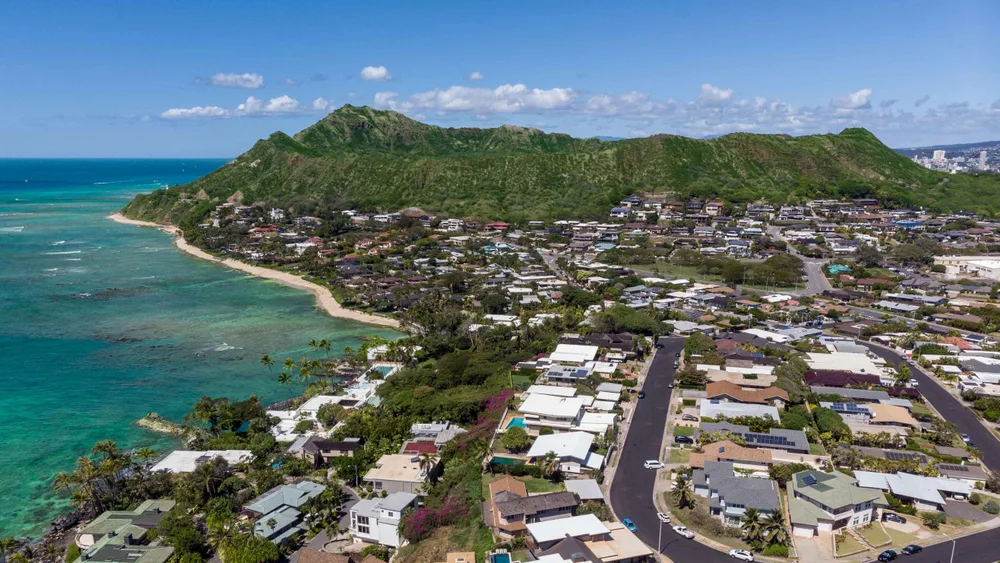
Mikela Bond/Shutterstock
After deciding on an island that seems like it’ll be a fit for you in terms of culture, landscapes, and cost of living, do some research to determine which area will be the right choice.
Chances are, that’ll be in one of the neighborhoods or areas listed below for each island.
Best Neighborhoods in Oahu
Oahu housing can be very expensive and the best neighborhoods are even more so. Moving to Oahu means you’ll likely be deciding between the following areas:
- Waikiki Beach: Six beaches, luxury amenities close by, safe, and walkable
- Diamond Head: East of Waikiki with lots of green spaces, short drive to the beach
- The Windward Coast: Quiet and more secluded area on the Eastern coast
- The North Shore: Huge surfing and native culture hotspot with laid-back vibes
- Honolulu: Urban, city vibes in a walkable city that’s crowded and vibrant
These are the most popular recommendations for where to stay in Oahu, but if you’re planning on moving here, you’ll want to consider the logistics.
That includes the average rent/mortgage costs, how walkable the area is, peak season crowds, local schools and jobs, and how many housing options are available.
Best Neighborhoods in Hawai’i
Housing on the Big Island of Hawai’i is less expensive than Oahu or Maui, but it’s still not cheap. If you’re thinking of moving to the Big Island, you’ll probably consider these areas:
- Hilo: Most populated area, very developed, beach access
- Kailua-Kona: Beach beaches on the island with lots of nightlife
- Kohala: Plenty of outdoor recreation on and off lava-rock and sandy beaches
- Volcano Village: Close proximity to Volcanoes National Park with a rural, artsy vibe
- Waikoloa: Quiet, friendly neighborhood with lots of resorts and beaches
These areas are some of our recommendations for where to stay on the Big Island, but they’re also excellent places to consider if you’re moving to Hawai’i.
With a lower housing cost than some of the other main Hawaiian islands and plenty of opportunities for shopping, jobs, and things to do in these areas, it’s easy to embrace the Big Island as your new home.
Best Neighborhoods in Maui
Maui is less expensive to live in than Oahu, but it’s still 56% higher than the national average.
Housing costs have historically been lower on Maui than on Oahu.
Note that the Lahaina wildfires displaced of thousands of people that have run into housing shortages as they scramble to find homes or apartments to rent on the island.
The fires damaged Lahaina, but the other areas in West Maui are still thriving and undamaged.
The best areas to consider on Maui are:
- West Maui: Ka’anapali, Napili, and Kapalua offer beaches, shops, golf courses, and nightlife
- Central Maui: More populated, close to shops and ample job opportunities with cooler temps
- South Side: Wailea, Makena, and Kihei offer the best beaches with more natural beauty and recreation
Although Central Maui is a little more crowded, it’s where you’ll find the most job opportunities on the island and benefit with slightly cooler temperatures.
If you love spending time outdoors, you might enjoy West Maui or the South Side of Maui even more.
Best Neighborhoods in Kauai
Kauai offers some excellent areas to live in and is one of the more affordable Hawaiian islands to move to with a lower cost of living than Oahu, Hawai’i, and Maui.
Some of the best neighborhoods to consider in Kauai are:
- Lihue: The capital and commercial center of Kauai with plenty of job opportunities and housing
- Kapa’a: Most populated area with national parks, beaches, and natural beauty/outdoor recreation
- Princeville and Hanalei: Northern Kauai with great beaches; less housing options, but quiet and safe
- Koloa: Tiny area with a cute downtown and excellent beaches, but more expensive housing
These areas rank among the top neighborhoods we recommend in our guide on where to stay in Kauai, but they’re just as appealing if you’re planning to move here.
One thing that all the different areas of Kauai have in common is that you won’t find much nightlife — if that’s not your scene, you’ll probably love it here.
4. Look at Housing Options
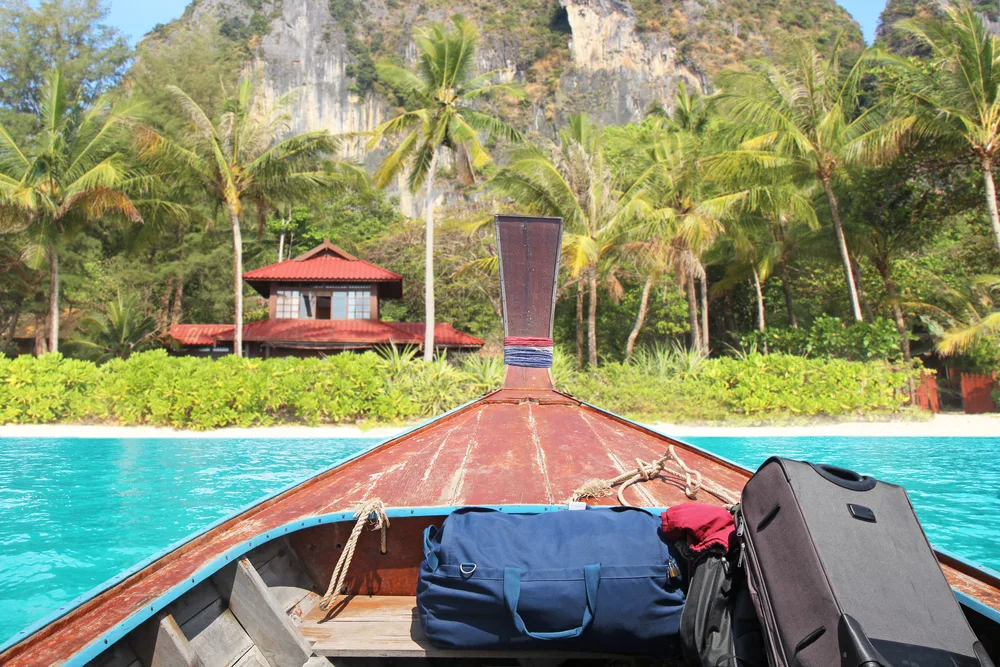
Anna Klepatckaya/Shutterstock
Housing is sometimes the factor that changes peoples’ minds about moving to Hawaii. It can be prohibitively expensive and sometimes hard to find houses for rent or sale.
The good news is that if you know which island and area you’re looking to settle down in, you’ll be able to focus your search and check around to find out what’s available in your price range.
Above, we mentioned that the median sold price of Hawaiian homes is over $638K. Keep in mind that that’s the median sold price — about half are higher and half are lower.
You’re probably not going to stumble upon any dirt-cheap real estate in the Hawaiian islands, but it’s not like you’ll have to spend millions to move here.
To get started on your home search in Hawaii, check out these websites to look for homes for rent or sale:
- HiCentral: Browse homes for sale or rent by island, neighborhood, listing date, and more
- Realtor.com: Browse homes for sale or rent by island, price, listing date, property type, and more
- HotPads: Browse private homes for rent (FRBO) by island, layout, listing date, and more
Remember the general housing costs in Hawaii by island: Oahu (214% higher than the national average), Hawai’i (47% higher), Maui (17% higher), and Kauai (16.5% higher).
5. Browse Job Openings
Securing a good job will make it much easier to seamlessly move to Hawaii and adjust to the higher cost of living there.
If you’re able to work remotely and earn a good salary, that’s a wonderful option.
In order to find a good job, you’ll want to know which industries are growing the most and have job openings available.
Here are the top employment industries in Hawaii and their growth from 2022-2023:
- Hospitality (13.6% growth)
- Transportation and warehousing (12.9% growth)
- Utilities and energy (5.9% growth)
- Administration and business support (4.5% growth)
- Real estate (3.8% growth)
- Retail (2.8% growth)
- Healthcare and social assistance (2.9% growth)
By the numbers, real estate, healthcare, and retail industries employ the most people in Hawaii. But these aren’t actually the top-growing industries — Hospitality, transportation, and utilities are!
If you already have a skillset that applies to these fast-growing industries or are willing to get the necessary training to do the work, it’s possible to find great employment options in Hawaii.
Get started on your job search by checking out the following websites for jobs in Hawaii:
- State of Hawai’i Careers
- Indeed
- City and County of Honolulu Jobs
- Hawaii County Jobs
- Kauai County Jobs
- Maui County Jobs
6. Sort Your Stuff to Ship or Sell
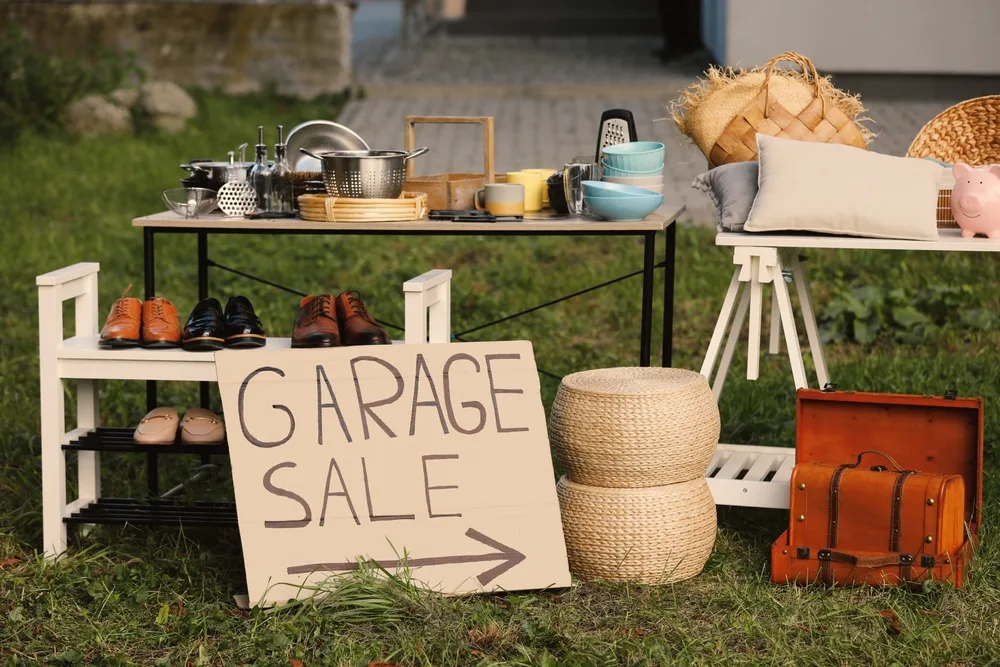
New Africa/Shutterstock
It’s starting to get real when you begin sorting through your accumulation of stuff to see what’s worth shipping and what you’d rather sell to help finance your move.
Shipping items to Hawaii isn’t cheap. At all.
If you ship your stuff in a pod, you could pay between $2,300 to $7,000+, according to estimates from Angi (formerly Angie’s List). Shipping furniture may be $1,000-$4,500 per item!
What about your car? Shipping it overseas ranges from $950 to over $3,000 if you’d rather not sell it.
These sky-high figures are why many people decide to sell what they can and only ship the absolute essentials when moving to Hawaii.
There are 3 saving graces to consider if the shipping costs are making you a little sick:
- If you’re moving to an area that’s walkable with lots to do in a small radius, you may not need a car right away (or at all).
- You might find a home to rent or buy that’s already furnished, meaning you won’t need to lug all your stuff along.
- The cash you make from selling unwanted items before the move can help cover shipping costs.
In any case, now is a great time to sit down with a notebook or spreadsheet and list out all the things you own, large and small, to determine if you’re better off paying to ship it or selling it now.
If you have plenty of time before your move, you can piece out items to sell in online marketplaces to get a better price for them. If you’re moving soon, it’s best to hold a huge yard sale and price things to sell quickly.
What you don’t sell can be donated to thrift shops and help centers near you.
7. Make the Move

fizkes/Shutterstock
Once you’ve landed on the right island for you, researched the COL, best neighborhoods, and housing/job options, and determined which items are coming with you, you’re ready to make the leap.
Actually moving to Hawaii is where things can get a bit hairy. There are a lot of (wait for it) moving parts.
You’ll be juggling the following:
- Booking your flight
- Arranging shipping for your items/car
- Working with a realtor or leasing agent for move-out/move-in
- Cutting off/setting up utilities
- Withdrawing/registering at your child’s new school
- Switching banks if needed
- Updating your address for bills, subscriptions, etc.
Make a moving checklist to ensure you don’t forget about anything important in the process of moving to a new state.
It seems like a lot and it won’t be a walk in the park, but waiting at the end of this laundry list of tasks is you, relaxing in your new Hawaiian home.
Is it worth it? We say definitely.
Things to Consider
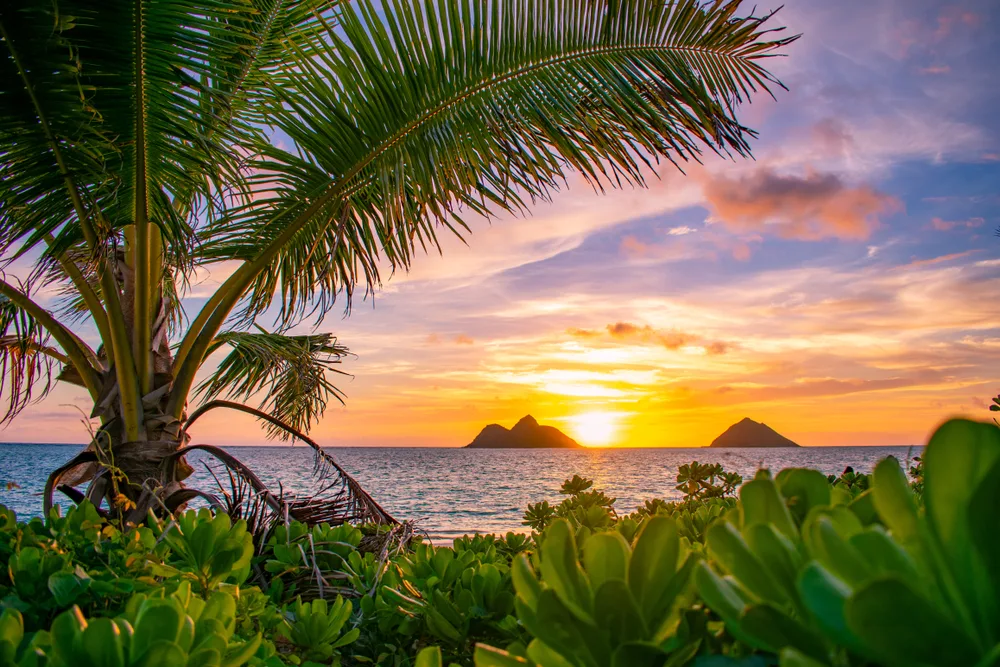
Mikela Bond/Shutterstock
When you’re considering how to move to Hawaii, it can be as overwhelming as it is exciting. Keep the following things in mind during the process to make it run as smoothly as possible.
- Visit before you commit. If you’re falling in love with a specific island or neighborhood just from the photos and info you’re seeing online, you’ll still want to visit in person before you settle on a destination. You might find that it’s not quite all it’s cracked up to be, or that a nearby town or area is an even better fit.
- Talk to locals. If you know anyone living in Hawaii, they can be a great, honest resource to chat with before you decide to move. They can be a great gateway to hear about the economic conditions, job outlook, cultural questions, hidden gems in the area, and more.
- Do lots of research. Learning how to move to Hawaii isn’t hard, but obtaining all the information you need to do it the right way takes time and patience. Do as much research as you can before settling on the idea. Your browser history should be full of online forums, photos, studies and economic data, pricing and cost trends, real estate listings, and more for the areas of Hawaii you’re interested in.
- Prepare for seasonal changes. The time of year you arrive in Hawaii could be the best part of the year, the worst, or somewhere in between. Know what’s coming in terms of seasonal changes with tourism, weather, shop closures, and more so you’re not taken by surprise.
Frequently Asked Questions

Maridav/Shutterstock
Figuring out how to move to Hawaii without making a mess of your plans is a little easier when you can look through some of the common questions others have about the process.
Check out the FAQs below to learn more!
How hard is it to move to Hawaii?
Moving to Hawaii isn’t hard, but it’s expensive and requires lots of planning. You’ll want to line up a great job to ensure your annual income is around $70K-$100K to live comfortably.
With a job and proof of income, you shouldn’t have trouble renting a home in Hawaii as long as you’re choosing an area with lots of available housing.
If you’re buying a home, having a sizable down payment and stable job history should help the process go smoothly.
Can I move to Hawaii without a job?
Moving to Hawaii without a job is possible, but not a good idea. You may be able to find a job in hospitality or retail once you move there, but finding a landlord that will rent a house or apartment to you will be difficult without proof of a current job.
It’s better to line up a job first, then move to Hawaii with plenty of money saved up to cover your first and last months’ rent and a security deposit.
How much do you have to make to move to Hawaii?
Many studies have looked at how much you have to make to move to Hawaii and live comfortably, with salary estimates ranging from $70K (single person) to almost $200K (family of 4) per year. Hawaii’s high cost of living (84% higher than the national average) means you’ll need a significant and steady income to make it here without struggling financially.
What I wish I knew before moving to Hawaii?
One thing that comes up over and over in “what I wish I knew before moving to Hawaii” discussions among transplants is how much more expensive everything is, from housing and gas to groceries and taxes.
The general recommendation is that you need to have a great, secure job, a place to live lined up, and a nice cushion of savings to make it in Hawaii.
What is the downside to living in Hawaii?
The downside to living in Hawaii is definitely the cost of living, which is about 84% higher than in the mainland. From a bag of cherries to shampoo, you’ll pay more for everything in Hawaii. Many people don't consider how different it can be to live on an island when coming from the mainland. "Island fever" is common and can make newcomers feel a bit trapped.
So, Ready to Pack Up and Move to Hawaii?
If you’re thinking about making a move to Hawaii, you already have your reasons — but that doesn’t mean you can’t find a few more.
You won’t find tropical scenery like this anywhere else in the US — white and golden beaches, verdant volcanic peaks and valleys, tropical flowers and trees, and ocean views that stretch for miles.
Whether you’re looking for rugged, all-natural beauty that surrounds you with Hawaii’s lush wildness or picturesque beaches surrounded by restaurants, shops, and attractions, you can find it in Hawaii.
If you’re getting bored with your current city, a move to Hawaii could be just the reboot you need.
There are endless fun things to do in Hawaii, from thrilling outdoor activities and laid-back days on the water to thriving local communities with festivals, events, and gatherings.
Since it’s warm in Hawaii year-round, it can be an amazing contrast to life in most parts of the contiguous US. Gone are the cold, snowy winters and naked trees in the cooler seasons.
Moving to the islands could help you discover a new love for connecting with nature through hiking, swimming, diving, rock climbing, or learning about the ancient use of medicinal native plants and herbs.
If you’re ready to turn over a new leaf — or palm frond — in Hawaii, follow these general steps to make your move a reality!



